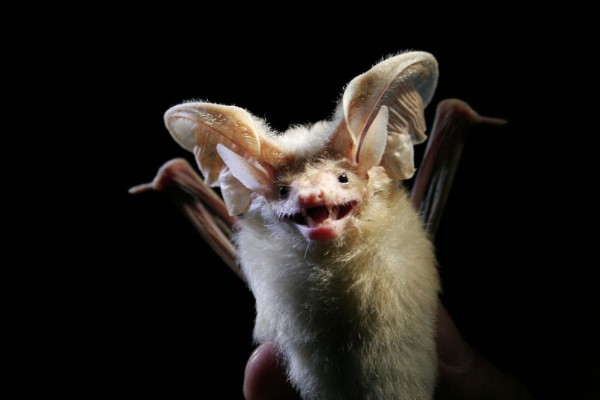Scientists Confirm First Bat Species that both "Screams" and "Whispers"
| Marc Maligalig | | Aug 19, 2014 01:33 AM EDT |
(Photo : Wikimedia Commons/ Charlotte Roemer)
Hemprich's long eared bats employ two kinds of echolocation to detect their prey, a capability never detected in bats before.
Biologists Talya Hackett and Carmi Korine made this new discovery after a detailed study of the bats in the deserts of the Middle East and North Africa.
Like Us on Facebook
With the help of fellow bat biologist Marc Holderied, Hackett and Korine studied the bats as they hunted in the gardens and deserts in Israel to figure out if they could really switch between predatory tactics on-the-go.
The researchers collected bat guano, or droppings, from Hemprich's bats (Otonycteris hemprichii) and recorded the flight paths of the bats.
The results suggest the bats sometimes fly slower or higher depending on whether they catch prey on the desert floor or at higher altitudes. At higher altitudes, the bats screamed louder than their normal gleaning sounds, reaching almost the same decibel level as aerial hawkers.
Bat droppings recovered showed bits and pieces of bees, butterflies, wasps, flies and other flying insects in addition to the their usual meals such as beetles, spiders and scorpions.
All the evidences suggests the bats are able to shift between the two exclusive calls for food, which was unheard of until the bat biologists concluded otherwise.
Bats fly at night by using echolocation, which is similar to the sonar used by submarines. The echolocating bats produce ultrasonic "shirps" by forcing air through their larynxes, or voiceboxes, and out of their noses or mouths.
The bouncing sounds give bats a map of their surroundings, making obstacles and prey visible.
There are two kinds of bats that use sound as a predatory tool.
There are the "aerial-hawkers" that use loud echolocation calls to locate and catch insects in flight and "gleaners" that use quieter calls to snatch prey off the ground.
In other words, bats are either "screamers" or "whisperers."
Some bats like Hemprich's long eared bats break through these boundaries and can go from a loud scream to a silent whisper if need be
Hemprich's long-eared bats are gleaners. They use soft echolocation to hunt for scorpions, spiders and large bugs on desert grounds.
Hackett and Korine noticed the bat calling out louder and taking a different flight pattern, imitating those of aerial-hawkers, in their study and were understandably puzzled, according to The Week.
Hemprich's long-eared bats are named after German naturalist and explorer Wilhelm Friedrich Hemprich.
TagsBat, Biologist, Research, Science, Desert, North Africa, Israel, Echolocation, Sonar, Bugs
©2015 Chinatopix All rights reserved. Do not reproduce without permission
EDITOR'S PICKS
-

Did the Trump administration just announce plans for a trade war with ‘hostile’ China and Russia?
-

US Senate passes Taiwan travel bill slammed by China
-

As Yan Sihong’s family grieves, here are other Chinese students who went missing abroad. Some have never been found
-

Beijing blasts Western critics who ‘smear China’ with the term sharp power
-

China Envoy Seeks to Defuse Tensions With U.S. as a Trade War Brews
-

Singapore's Deputy PM Provides Bitcoin Vote of Confidence Amid China's Blanket Bans
-

China warns investors over risks in overseas virtual currency trading
-

Chinese government most trustworthy: survey
-

Kashima Antlers On Course For Back-To-Back Titles
MOST POPULAR
LATEST NEWS
Zhou Yongkang: China's Former Security Chief Sentenced to Life in Prison

China's former Chief of the Ministry of Public Security, Zhou Yongkang, has been given a life sentence after he was found guilty of abusing his office, bribery and deliberately ... Full Article
TRENDING STORY

China Pork Prices Expected to Stabilize As The Supplies Recover

Elephone P9000 Smartphone is now on Sale on Amazon India

There's a Big Chance Cliffhangers Won't Still Be Resolved When Grey's Anatomy Season 13 Returns

Supreme Court Ruled on Samsung vs Apple Dispute for Patent Infringement

Microsoft Surface Pro 5 Rumors and Release Date: What is the Latest?










